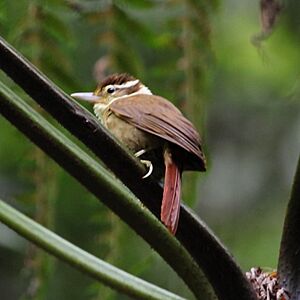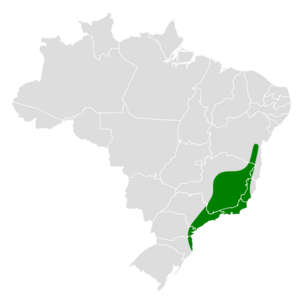White-collared foliage-gleaner facts for kids
Quick facts for kids White-collared foliage-gleaner |
|
|---|---|
 |
|
| at Intervales State Park, São Paulo State, Brazil | |
| Conservation status | |
| Scientific classification | |
| Genus: |
Anabazenops
|
| Species: |
fuscus
|
 |
|
The white-collared foliage-gleaner is a special type of bird. It belongs to the ovenbird family, called Furnariidae. This bird lives only in eastern Brazil. Its scientific name is Anabazenops fuscus.
Contents
About Its Family
Birds are grouped into families, just like people have last names. This helps scientists understand how they are related. The white-collared foliage-gleaner is in the same group, or genus, as the bamboo foliage-gleaner. This bird is also "monotypic," which means it is the only species in its group that doesn't have different subspecies.
What It Looks Like
The white-collared foliage-gleaner is about 20 centimeters (8 inches) long. It has a large, wedge-shaped beak. Both male and female birds look the same.
Head and Neck
This bird has a clear whitish stripe above its eye. Its face is dark brown, but the area around its mouth is white. The top of its head is a rich dark brown. It has a wide white band that goes all the way around its neck. Its throat is also white.
Body and Wings
The bird's back and rump are a lighter brown than its head. Its tail is a dark reddish-brown color. Its wings are the same brown as its back. The bend of its wing is a bright yellowish-brown.
Underside
Its upper chest is grayish-yellow. This color changes to a darker brownish color on its lower chest and belly. The sides of its body and under its tail are even darker brown.
Eyes, Beak, and Legs
Its eyes are dark brown or reddish-brown. The top part of its beak is dark brown with a light edge. The bottom part of its beak is light gray or horn-colored. Its legs and feet can be olive-gray, brownish-gray, or dark olive-brown. Young birds look similar to adults, but their eye stripe and underside might have a yellowish-brown tint.
Where It Lives and Its Home
The white-collared foliage-gleaner is found in southeastern Brazil. You can see it from the states of Bahia and Minas Gerais down to Santa Catarina.
Its Habitat
It lives in mountain evergreen forests. This includes both old, untouched forests and forests that have grown back. It especially likes areas with large, thick bamboo plants. These birds usually live at elevations between 350 and 1,200 meters (about 1,150 to 3,900 feet) above sea level.
How It Behaves
Movement
This bird stays in the same area all year round. It does not migrate to different places.
Feeding Habits
The white-collared foliage-gleaner eats arthropods, which are like insects and spiders. It usually hunts for food in pairs. Sometimes, it will join groups of different bird species that are also looking for food.
It mostly searches for food in the middle parts of the forest trees. It might look in the lower parts of the forest, but it rarely searches on the ground. This bird is very agile. It climbs up vertical plant stems. It pecks and probes for prey on the stems and among green and dead leaves. A lot of its food comes from bamboo plants.
Reproduction
Scientists believe that white-collared foliage-gleaners stay with one partner. They build their nests in natural holes found in tree branches. Not much else is known about how they raise their young.
Vocalization
The white-collared foliage-gleaner has a unique song. It sounds like a "high, musical, slightly lowered 'djepdjep---'". It also makes "low-pitched, evenly spaced 'tchook' notes" that get louder. Other calls include a "high-pitched, squeaky 'chek, jééurr-jééurr-jééurr-jééurr-jééurr'" and a "hoarse, syncopated 'wrr-jek, wrjejek, wrrjejek'". Its alarm call is a sharp "ghéé-eh".
Its Conservation Status
The IUCN (International Union for Conservation of Nature) keeps track of how many animals are left. They first thought the white-collared foliage-gleaner was "Near Threatened." But since 2004, they have changed its status to "Least Concern." This means it is not currently in danger of disappearing.
Threats to the Bird
Even though it's "Least Concern," this bird lives in a somewhat small area. We don't know exactly how many there are, but their numbers are thought to be going down. No immediate dangers have been found. It is considered fairly common and lives in several protected areas. However, a lot of its forest home has been cut down. This has greatly reduced the places where it can live.


